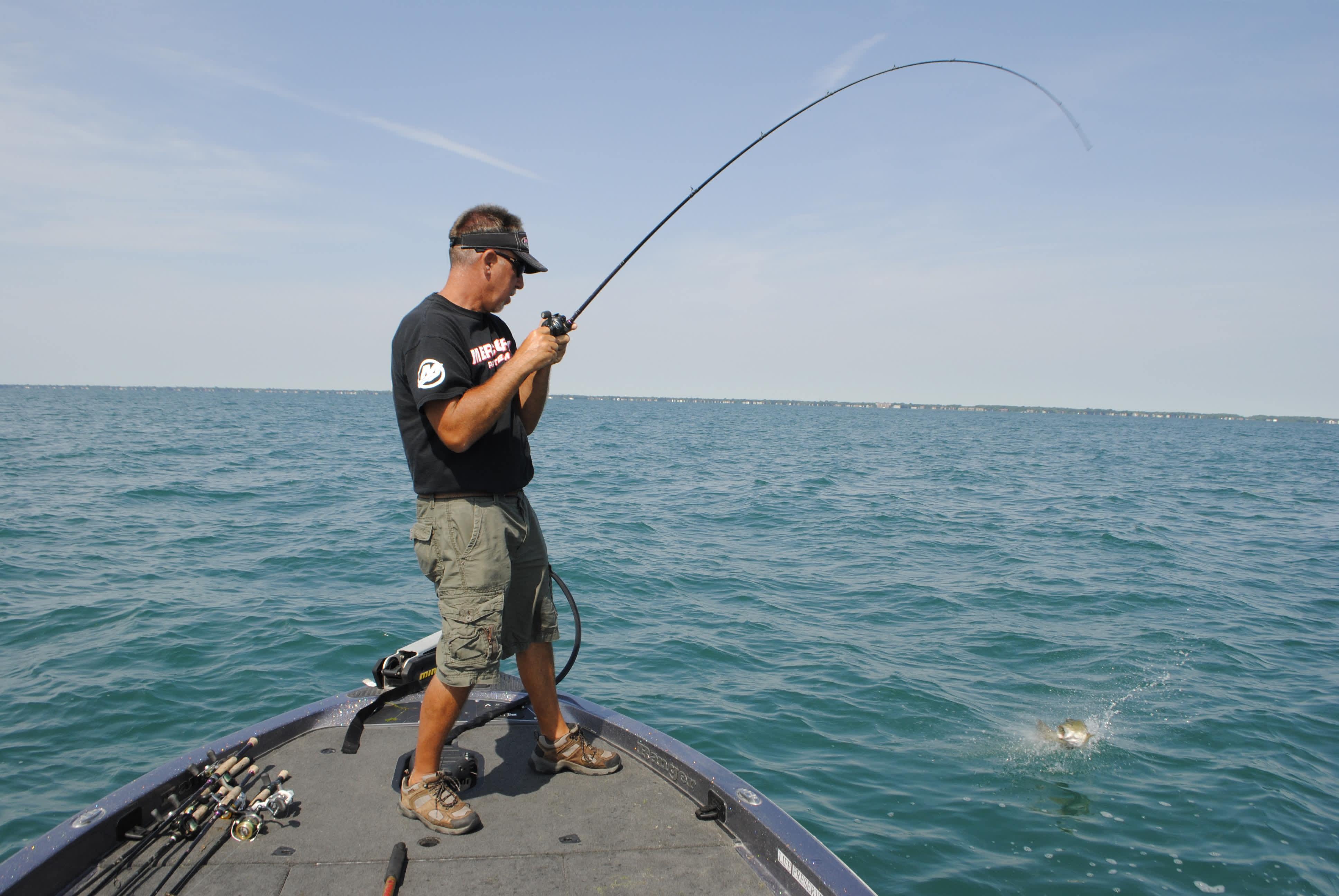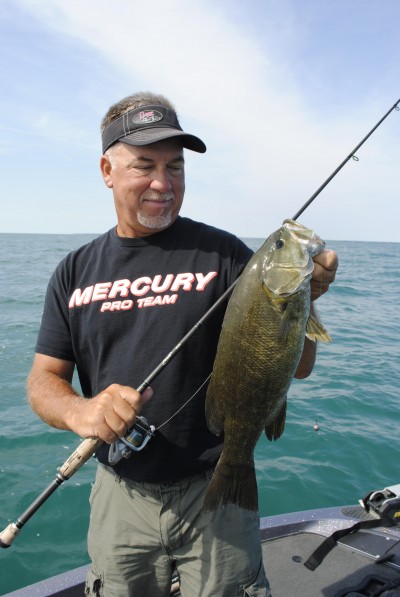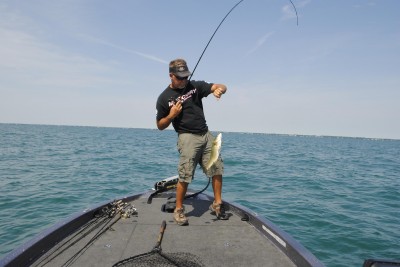Drop Shots and Tubes for Lake St. Clair Smallmouth Bass
Bob Gwizdz 08.26.13

Our first drift in Lake St. Clair, maybe 90 minutes over 15 feet of water with isolated patches of sand grass about five miles offshore, resulted in seven smallmouth bass (and a couple of rock bass). Neither fast, nor furious, but solid; the fish probably averaged a little better than two pounds.
Out next pass, a short distance away in similar water, we caught 13.
Twenty bass in three hours. Very solid.
“Well, now that we’ve caught some fish, let’s go find some big ones,” said my host, Marcel Veenstra.
We moved a few miles to what seemed like similar water, but there was a difference: the fish weren’t there.
“They move in and out of here,” Veenstra said. “They were in here really good last summer but apparently they’re not here yet. But everything’s a little bit behind this summer.”
Two hours of fishing—me with a drop shot rig, Veenstra with a tube—produced one smallmouth (and a couple of rockies).

Oh, well. We moved back toward where we started and the catching commenced.
“I really can’t tell you why they’re here,” Veenstra said, as he boated a 3-1/2-pounder. “But they are.”
Over the next hour we caught another 20, a few dinks, but mostly solid, fat chunks, pushing a three-pound average (Veenstra noted that the fishing generally picked up in the afternoon). It’s no wonder why Bassmaster magazine has dubbed Lake St. Clair the best bass lake in America. The proof was in the catching. The rap on St. Clair—and you’re really picking nits to find something to complain about—is that it doesn’t produce a lot of giants. And though it often produces 20-pound-plus bags of bass (five fish) to the tournament guys, they sometimes have to catch a lot fish to get there.
That’s something to complain about?
“I’ve been in a little bit of a four-pound drought,” said Veenstra. “It’s been a couple of days. I’m not 100 percent exactly sure what happened.”
What’s the saying—“sun don’t shine on the same dog’s butt every day?”
I was fishing a drop shot rig with the bait about a foot up the line from the sinker on braided line with about an eight-foot length of eight-pound test fluorocarbon leader on one of Veenstra’s rods. I was doing just fine.
“I like about a seven-foot rod with a lot of give,” he explained. “A lot of times you can reel a fish right up to the boat and that’s when they make their run. Since fluorocarbon has so little give, that’s when you need a soft rod or they can break you off.”
Veenstra says he likes tungsten weights when drop shotting because it gives a better feel for the bottom.
“You can tell whether you’re on rock or sand because of the density of the weight,” he said. “Tungsten’s really good when it’s windy.”
I was using a 3-1/4-inch green pumpkin Lil’ Stick made by Case plastics.
“It’s like a Senko but a little bit fatter and a little bit longer,” Veenstra said. “But I do drop shot with small tubes, too.”
The advantage of drop shotting is it keeps the bait just above the sand grass, which only grows up a few inches off the bottom.

“On a lot of days, especially flat sunny days, the drop shot is more appealing than a tube on the bottom,” Veenstra said. “The drop shot weight might get into the grass a bit, but the bait stays clear. A tube will hang up in the grass.
“There are fish that’ll eat a drop shot better than a tube—and vice versa,” he continued. “There are days when one is significantly better than the other.”
One the other hand, Veenstra said, tubes tend to catch a slightly bigger fish, on average, than the smaller drop shot worms
“It’s the profile—a bulkier bait basically,” he said. “The drop shot is more of a finesse-style bait. But with two guys fishing, you can mix it up.”
Veenstra is a veteran touring pro from the East Coast who moved to Michigan about a decade ago, started a guiding business, and has been happy with that decision.
“I enjoy teaching,” he said, “and there are a lot of folks who understand what’s going on out there. That’s a big part of guiding.”
As afternoon began shifting into evening, Veenstra suggested we take one more crack at finding some big fish. We spent a half hour fishing some rocky-bottomed water, 15 to 17 feet, and caught two more, both healthy three-pound plus smallies, but Veenstra’s “four-pound drought” continued. As it was we caught more than 40 smallmouths—and enough rock bass to put on a good fry, if we’d been so inclined—fishing a little over seven hours.
The only thing that disappointed me was I wasn’t able to help Veenstra break his drought (now who’s picking nits?).
To contact Veenstra, visit www.marcelsguideservice.com or call (810) 923-5035.
For more information on Michigan fishing go to michigan.org. Click here to purchase a Michigan fishing license online.

